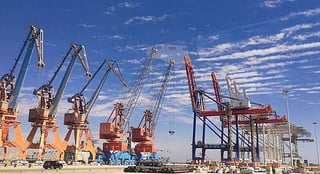
The Gwadar Port (Urdu: گوادر بندرگاہ [ˈɡwaːdəɾ ˈbəndəɾɡaː]) is situated on the Arabian Sea at Gwadar in Balochistan province of Pakistan and is under the administrative control of the Maritime Secretary of Pakistan and operational control of the China Overseas Port Holding Company. The port features prominently in the China–Pakistan Economic Corridor (CPEC) plan, and is considered to be a link between the Belt and Road Initiative and the Maritime Silk Road projects. It is about 120 kilometres (75 mi) southwest of Turbat, and 170 kilometres (110 mi) to the east of Chabahar Port (Sistan and Balochistan Province in Iran). Gwadar's potential to be a deep water sea port was first noted in 1954, while the city was still under Omani sovereignty. Plans for construction of the port were not realised until 2007, when the port was inaugurated by Pervez Musharraf after four years of construction, at a cost of $248 million. In 2015, it was announced that the city and port would be further developed under CPEC at a cost of $1.62 billion, with the aim of linking northern Pakistan and western China to the deep water seaport. The port will also be the site of a floating liquefied natural gas facility that will be built as part of the larger $2.5 billion Gwadar-Nawabshah segment of the Iran–Pakistan gas pipeline project. Construction began in June 2016 on the Gwadar Special Economic Zone, which is being built on 2,292-acre site adjacent to Gwadar's port. In late 2015, around 2000 acre land was leased to a Chinese company for 43 years for the development of Gwadar Special Economy Zone. Gwadar Port became formally operational on 14 November 2016, when it was inaugurated by Pakistan's Prime Minister Muhammad Nawaz Sharif; the first convoy was seen off by the then Pakistan's Chief of Army Staff, General Raheel Sharif. On 14 January 2020, Pakistan operationalized Gwadar Port for Afghan transit trade. On 31 May 2021, Gwadar Port became fully operational, along with the availability of online booking for the delivery of goods. From Wikipedia
